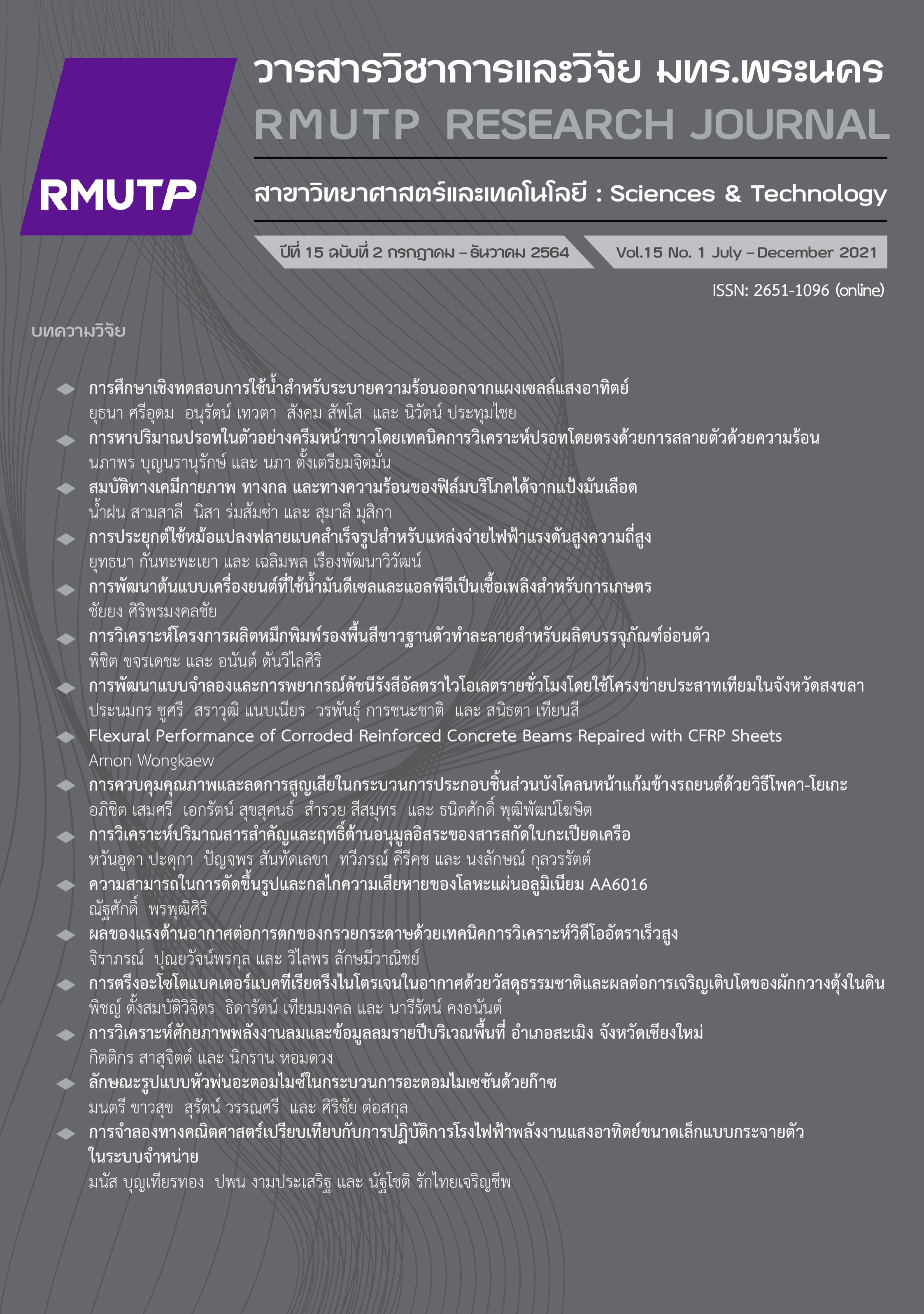Immobilized Free Nitrogen-Fixing Bacteria Azotobacter in Natural Materials and Its Effect on Growth of Brassica Chinensis in Soil
Main Article Content
Abstract
Nitrogen is an essential nutrient for plant growth. When the plants have been grown for a long-term, effect to decreased nitrogen in soil and insufficiency of the plant growth. One biological method for increasing the nitrogen content in soil is utilize of free nitrogen-fixing bacteria Azotobacter. Therefore, the objective of this research was to search natural material suitable for Azotobacter fixation. The 10 natural materials were observed physical structure and investigated the ability of natural materials for Azotobacter fixation. The results showed that water hyacinth and bagasse stalks were fixed the Azotobacter of 2.43x108 and 1.94 x108 CFU per gram of each natural material, respectively. After that, the selected fixed Azotobacter of water hyacinth and bagasse stalks were studied the growth of Brassica Chinensis. This experiment was designed to 4 treatments. The first treatment was mixed of water hyacinth stalks and the Azotobacter. Second treatment was mixed of bagasse stalks and the Azotobacter. The third treatment was the Azotobacter only. The last treatment was soil only. The results indicated that the average of plant growth include height, leaf number, root length, fresh weight and dry weight of the mixed of water hyacinth stalks and the Azotobacter had significantly higher growth rates than other treatments. The total nitrogen was also increased 1.4 fold in the soil. All results suggest that the water hyacinth stalk is alternative for the fixation of the free nitrogen-fixing bacteria Azotobacter as induce nitrogen in the soil and plant growth promotion.
Article Details

This work is licensed under a Creative Commons Attribution-NonCommercial-NoDerivatives 4.0 International License.
ลิขสิทธ์ ของมหาวิทยาลัยเทคโนโลยีราชมงคลพระนครReferences
Y. Osotspa, A. Wongmaneeroj and Ch. Hongprayoon, Fertilizers for sustainable agriculture, 2 nd ed. Bangkok: Kasetsart University Press, 2011.
Y. Osotspa, Plant nutriention, 4 th ed. Bangkok: Kasetsart University Press, 2015.
S. Torpee, “Selection of free living aerobic nitrogen fixing bacteria and Bacillus sp. to use as inoculums for nitrogen and phosphorus fertilizer in straw medium,” Prince of Songkla University Thesis, 2009.
A. Chanchaichaovivat, S. Kirdtabtim and S. Phornphisutthimas, “Application of microorganisms in sustainable agriculture,” Journal of Research Unit on Science, Technology and Environment for Learning, vol. 7, no. 2, pp. 398-413, Dec. 2016.
S. Mahdi, H. Mukhtar, H. Bashir and A. Nawaz, “Optimization of growth conditions for Azotobacter species and their use as biofertilizer,” Journal of Bacteriology & Mycology, vol. 6, no. 5, pp. 274-278, Sep. 2013.
N.A. Thazin, S. Nourmohammadi, E.M. Sunitha and M. Myint, “Isolation of endophyticbacteria from green gram and study on their plant growth promoting activities,” International Journal of Applied Biology and Pharmaceutical Technology, vol. 2, no. 3, pp. 525-537, Jul. 2011.
D. Rojas-Tapias, A. Moreno-Galvan, S. Pardo-Diaz, M. Obando, D. Rivera and R. Bonilla, “Effect of inoculation with plant growth-promoting bacteria (PGPB) on amelioration of saline stress in maize (Zea mays),” Applied Soil Ecology, vol. 61, pp. 264 – 272, Oct. 2012.
A. Beneduzia, F. Moreirab, P. B. Costa, L. K. Vargas, B. B. Lisboa, R. Favreto, J. I. Baldani and L. M. P. Passaglia, “Diversity and plant growth promoting evaluation abilities of bacteria isolated from sugarcane cultivated in the South of Brazil,” Applied Soil Ecology, vol. 63, pp. 94 – 104, Jan. 2013.
S. Suphan, P. Prajankett and S. Pongsawat, “Using Nitrogen Fixing Bacteria with Biological Supporting Media for Promoting the Plant Growth,” Science and Technology RMUTT Journal, vol. 6, no. 2, pp. 17-28, Dec. 2016.
J. C. Santos, S. I. Mussatto, G. Dragone, A. Converti and S. S. Siva, “Evaluation of porous glass and zeolite as cells carriers for xylitol production from sugarcane bagasse hydrolysate,” Biochemistry Engineer Journal, vol. 23, no. 1, pp. 1-9, Mar. 2005.
P. S. Bisen, M. Debnath and G. B. K. S. Prasad, Microbes: Concepts and Applications. 1 st ed. Malden: Wiley-Blackwell Publishing, 716 p., 2012.
J. G. Holt, N. R. Krieg, P. H. A. Sneath, J. T. Staley, and S.T. Williams, Bergey’s Manual of Determinative Bacteriology, 9 th ed. Philadelphia: Lippincott Williams & Wilkins, PA., 2000.
C. Kaewkrajay and P. Sinthunawa, “Immobilization of Saccharomyces cerevisiae to Sugarcane Bagasse for Fuel Ethanol Production,” Burapha Science Journal, vol. 20, no. 2, pp. 96-111, Aug. 2015.
O. Suttinun, W. Kaewtip and E. Luepromchai, Phenol degradation by mixed culture of Methylobacterium sp.NP3 and Acinetobacter sp. PK1 immobilized on oil palm residues, Prince of Songkla University, 2010.
W. Soontornchaiboon and R. Pawongrat, “Utilization of natural wastes as supporting materials for cell immobilization and Its application for ethanol production,” Veridian E-Journal, SU, vol. 6, no. 1, pp. 795-807, Jan.-Apr. 2013.
P. Tangsombatvichit and D. Ketrot, “The quality of vermicompost from sweet potato crop wastes and its impact on growth promotion of Brassica chinensis,” RMUTSB Academic Journal, vol. 6, no. 2, pp. 124-133, Sep. 2018.
Y. Kourkoutas, A. Bekatorou, I. M. Banat, R. Marchant and A. A. Koutinas, “Immobilization technologies and support materials suitable in alcohol beverages production: a review,” Food Microbiology, vol. 21, no. 4, pp. 377–397, Aug. 2004.


